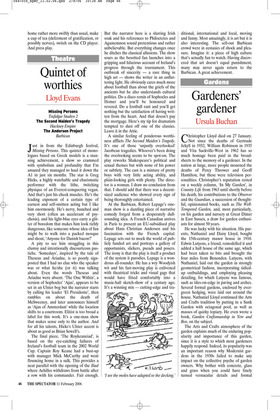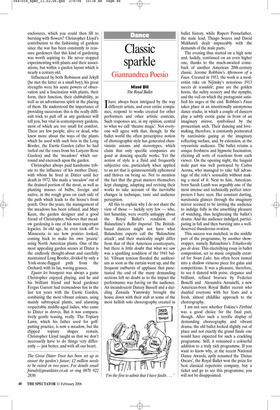Gardeners’ gardener
Ursula Buchan
Christopher Lloyd died on 27 January. Not since the deaths of Gertrude Jekyll in 1932, William Robinson in 1935 and Vita Sackville-West in 1962 has so much homage been paid in the broadsheets to the memory of a gardener. In the nation at large, more people mourned the deaths of Percy Thrower and Geoff Hamilton, but these were television personalities. Christopher’s reputation rested on a weekly column, ‘In My Garden’, in Country Life from 1963 until shortly before his death, his contributions to the Observer and the Guardian, a succession of thoughtful, opinionated books, such as The WellTempered Garden, and, most particularly, on his garden and nursery at Great Dixter in East Sussex, a draw for garden enthusiasts for almost 50 years.
He was lucky with his situation. His parents, Nathaniel and Daisy Lloyd, bought the 15th-century manor house in 1910. Edwin Lutyens, a friend, remodelled it and added a hall house of the same age, which had been taken to bits and brought the four miles from Benenden. Lutyens, with Nathaniel, laid out the garden in strongly geometrical fashion, incorporating tidiedup outbuildings, and employing pleasing detailing, for which Lutyens was famous, such as tiles-on-edge in paving and arches. Several formal gardens, enclosed by evergreen hedging, were laid out around the house. Nathaniel Lloyd continued the Arts and Crafts tradition by putting in a Sunk Garden with octagonal pool, as well as masses of quirky topiary. He even wrote a book, Garden Craftsmanship in Yew and Box, on the subject.
The Arts and Crafts atmosphere of the garden explains much of the enduring popularity and importance of this garden, since it is a style to which most gardeners happily respond. Indeed, its popularity was an important reason why Modernist gardens in the 1930s failed to make any impact on the collective psyche of garden owners. Why bother with concrete, glass and grass when you could have finely turned vernacular details and formal enclosures, which you could then fill to bursting with flowers? Christopher Lloyd’s contribution to the fashioning of gardens since the war has been constantly to reassure gardeners that this kind of gardening was worth aspiring to. He never stopped experimenting with plants and their associations, but within a garden layout which is nearly a century old.
Influenced by both Robinson and Jekyll (he met the latter as a small boy), his great strengths were his acute powers of observation and a fascination with plants, their form, their function, their clubbability, as well as an adventurous spirit in the placing of them. He understood the importance of providing succession; this is the really difficult trick to pull off as any gardener will tell you, but vital in contemporary gardens, most of which are too small for comfort. There are few people, alive or dead, who knew more about the ways of the plants which he used with such brio in the Long Border, the Exotic Garden (after he had turfed out the roses from his Lutyens Rose Garden) and the ‘meadows’ which surround and encroach upon the garden.
Christopher always paid handsome tribute to the influence of his mother Daisy, with whom he lived at Dixter until her death in 1972. She made a ‘meadow’ out of the drained portion of the moat, as well as planting masses of bulbs, foreign and native, in the rough grass on each side of the path which leads to the house’s front porch. Over the years, the management of the meadows has been refined, and Mary Keen, the garden designer and a good friend of Christopher, believes that meadow gardening is one of his most important legacies. In old age, he even took off to Minnesota to see how prairies looked, coming back to make his own ‘prairie’ using North American plants. One of the most appealing garden scenes at Dixter is the endlessly thought-about and carefully maintained Long Border, divided by only a York-stone-flagged path from the Orchard, with its lax, waving grasses.
Epater les bourgeois was always a game Christopher enjoyed playing, and he and his brilliant friend and head gardener Fergus Garrett had tremendous fun in the last ten years with the Exotic Garden, combining the most vibrant colours, using mainly subtropical plants, and alarming respectable middle-aged ladies, who came to Dixter in droves. But it was comparatively gentle teasing, really. The Topiary Lawn, which his father used for golfputting practice, is now a meadow, but the clipped topiary shapes remain. Christopher Lloyd taught us that we don’t necessarily have to do things very differently — just better, and with all our heart.
The Great Dixter Trust has been set up to ensure the garden’s future; £2 million needs to be raised in two years. For details email friends@greatdixter.co.uk or ring 0870 922 2830.















































 Previous page
Previous page